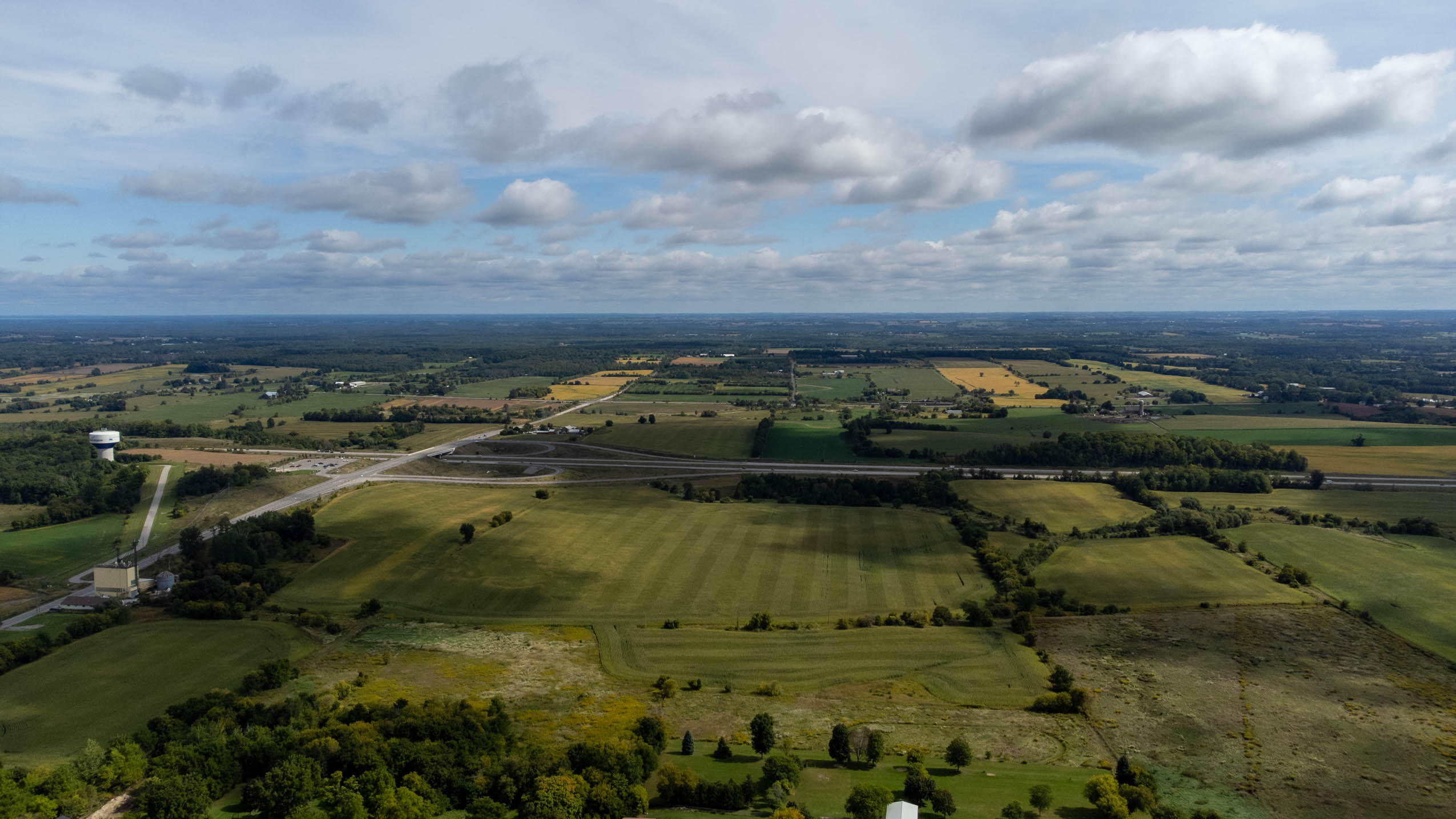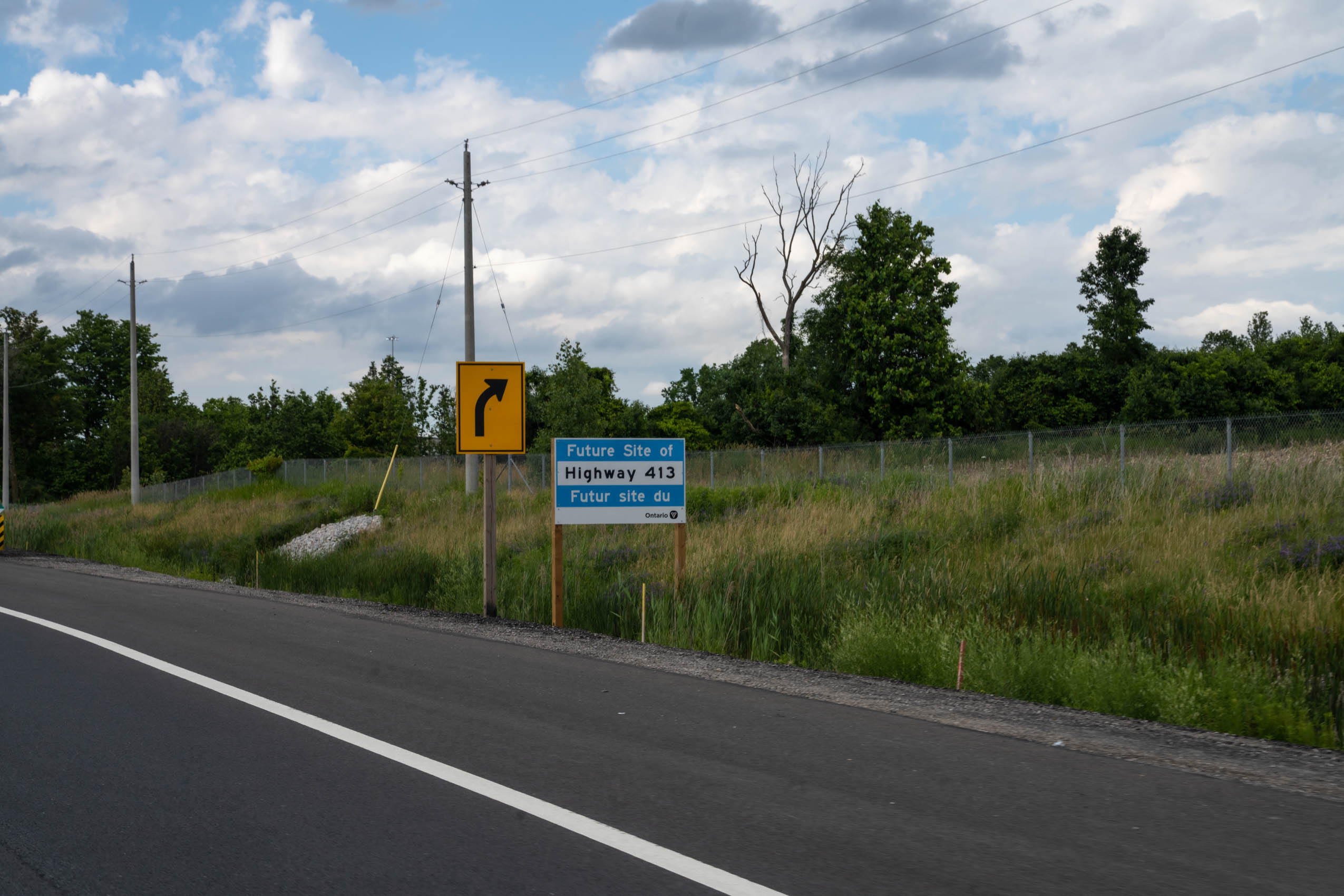
Rocky Mountain coal mine in Alberta takes next step to expansion
In Alberta, a massive open-pit coal mine near Jasper National Park is hoping to expand...
The Ontario government doesn’t know when Highway 413 will be finished but it will likely take at least a decade, an internal document shows.
Highway 413 is a flagship project for Premier Doug Ford’s Progressive Conservatives. If built, its 59-kilometre path would connect Toronto’s northern and western suburbs, cutting across farmland, wetlands, waterways and Ontario’s Greenbelt.
Publicly, the province has touted its progress on the controversial project, with Transportation Minister Prabmeet Sarkaria saying he hopes to get shovels in the ground next year for early work on the highway, like bridges. But an internal government document, obtained by The Narwhal through access to information legislation, shows the Ministry of Transportation has “no commitment to a timeline” for finishing the project or even finalizing its design. That means the province is poised to start building without full knowledge of what its impacts will be on environmentally sensitive land or how to minimize them.
“Currently there is no commitment to a timeline for detail [sic] design and construction,” the document reads.
“The timing and duration of highway construction depends on numerous factors, including size and complexity of the project, funding availability, procurement method and timing of environmental clearances and permits.”
The document is a June 2023 draft of a report about Highway 413 that the province had to prepare for a federal review of the project. The Trudeau government started the review in 2021, citing three federally protected species at risk and public concern about the project. The process effectively paused the project for three years, but earlier this spring, the federal government dropped the assessment amid a court battle with Ontario. The decision cleared the way for the province to go full-steam ahead, with some oversight by a joint federal-provincial working group.
Even so, the highway is many years away from the first cars hitting the pavement. The province still needs to secure key provincial and federal permits to go ahead. Once it has them, the detailed design and construction of the project will take at least another 10 years, the internal report notes.
Laura Bowman, a staff lawyer with the environmental charity Ecojustice, said the government’s move to start construction without having a final plan is “all smoke and mirrors,” and Highway 413 may not be financially or environmentally viable in the end. The long timeline means a high chance another party could take power in the interim, which could result in significant changes to the project or even a cancellation.
“There is a risk that the government will start destroying farmland and habitat to put on a show that construction is beginning for voters before the next election,” Bowman said in a statement.
“Ontarians may well find that they suffer the environmental and financial costs of this poorly planned and rushed project without any benefits.”
Ontario’s next province-wide vote is scheduled for June 2026, but the premier has declined to rule out calling an election early.



Dakota Brasier, a spokesperson for Sarkaria, acknowledged but did not answer detailed questions about the timeline for the project, and whether the government is rolling the dice by beginning construction before finalizing the highway’s design.
In a video posted on social media soon after this story was published, Ford and Sarkaria trumpeted their work on the project and reiterated plans to start construction next year — but acknowledged that the government’s plans are not yet complete. Crews are testing soil and bedrock conditions right now, Ford said in narration over footage of him and Sarkaria visiting a work site. The “next phase,” he added, involves designing bridges for the section of highway passing over the environmentally-sensitive Humber Valley. Ford also said the project would create 3,500 jobs per year and contribute $350 million to Ontario’s economy.
“We can’t wait to get it done,” Ford said, without offering details on when the highway will open.
“It’s not surprising that the Ford government has no actual plan for this highway,” Ontario NDP Leader Marit Stiles said in a statement, responding to the document obtained by The Narwhal.
“It’s been clear for a long time that they’ve got no answers when it comes to how much the 413 would cost or how many decades it would take to finish.”
Building a highway is a huge task that normally takes many years. In 2011, the previous Liberal government said constructing major highways could take eight years from start to finish. In Nova Scotia, the provincial government says such projects take an average of five to 10 years. And more recently, major infrastructure builds across the country were delayed by COVID-19 lockdowns.
Irene Ford, who lives in Vaughan, Ont., near the eastern end of the proposed highway, is a longtime opponent of the project through groups like Stop the 413. She said the document shows the government isn’t being honest with the public about the reality of the project.
“It just reinforces what the community has been saying about a complete disconnect between what our politicians are stating, what they’re advocating and what they’re telling the public,” she said.

Ontario has said it plans to start expropriating land for the new highway this year, a process that could be sped up by a bill that was introduced earlier this year but isn’t yet in force. In the meantime, the Ministry of Transportation is still negotiating with the federal government: the new federal-provincial working group met for the first time in June and will keep going until the two levels of governments reach consensus, the Impact Assessment Agency of Canada said in an email.
“There is no set timeline or deadline set for the working group to complete its work,” the agency said in a statement.
The agency didn’t directly answer when asked whether the federal government might subject the highway to another review if Ontario and Canada can’t agree on a path forward.
“New designation requests will be assessed on a case-by-case basis,” the agency said.
The idea of Highway 413 has been on the books for decades as a potential fix for the Greater Toronto Area’s clogged highways.

A previous Liberal government shelved the project after an independent panel concluded it would save drivers across the region less than a minute. Ford’s Progressive Conservatives put it back on the table in 2018 and made it a major plank of their re-election campaign in 2022, arguing that while the impact on roads across the region is minimal, it would save drivers travelling the length of the highway half an hour. The province has also argued that with gridlock forecast to get worse in the coming decades, new highway capacity is needed just to accommodate the number of cars on the road.
The opposition NDP has said the province should instead consider a different solution: allowing trucks to use nearby Highway 407 toll-free, which the same previous Liberal government panel found would deliver comparable benefits.
Meanwhile, critics — environmentalists, several municipalities along the route and even some local conservative politicians — have said the project isn’t a good idea. Many have pointed to decades of science showing new highways attract more drivers and make traffic congestion worse in the long run. They also point to concerns about the project’s environmental impact.
Aside from cutting through sections of Ontario’s Greenbelt, Highway 413 would also cross three parcels of conservation land north of Toronto, and prime farmland. As of 2022, the Ontario government had found 11 species at risk along its proposed path. Highways also tend to drive higher levels of air pollution.
In 2021, the highway also ignited controversy after the Toronto Star and National Observer reported eight powerful developers owned more than 3,300 acres, or about 13 square kilometres, of land near the highway’s proposed path. Many were prolific PC donors and set to see the value of the properties skyrocket if the 413 is built.
The Ontario government hasn’t given a precise estimate for how much it’ll cost to build Highway 413. The province’s auditor general found in 2022 that it would likely cost more than $4 billion, and that the Ford government had prioritized the project against the advice of internal experts. Opposition parties have said the true cost could be closer to $10 billion.
Updated July 4, 2024, at 1:50 p.m. ET: This article was updated to include details of a video that was posted on social media by the Ford government after publication.
Get the inside scoop on The Narwhal’s environment and climate reporting by signing up for our free newsletter. A $335 million funding commitment to fund...
Continue reading
In Alberta, a massive open-pit coal mine near Jasper National Park is hoping to expand...

A trade war could help remake B.C.’s food system, but will family farmers be left...

First Nations are leading efforts to make sure lake sturgeon can find a home in...
